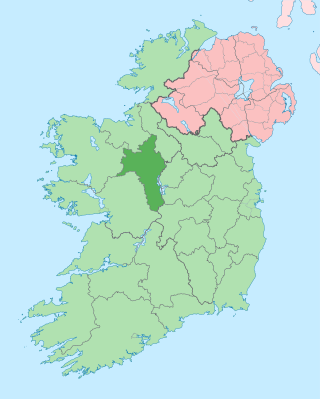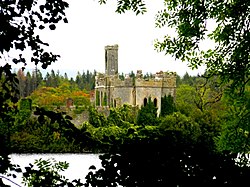
County Roscommon is a county in Ireland. It is part of the province of Connacht and the Northern and Western Region. It is the 11th largest Irish county by area and 27th most populous. Its county town and largest town is Roscommon. Roscommon County Council is the local authority for the county. The population of the county was 69,995 as of the 2022 census.
Roscommon is the county town and the largest town in County Roscommon in Ireland. It is roughly in the centre of Ireland, near the meeting of the N60, N61 and N63 roads.

Urquhart Castle is a ruined castle that sits beside Loch Ness in the Highlands of Scotland. The castle is on the A82 road, 21 kilometres (13 mi) south-west of Inverness and 2 kilometres (1.2 mi) east of the village of Drumnadrochit.

Lough Key is a lake in Ireland. It is in the northwest of County Roscommon, northeast of the town of Boyle. The lough is believed to be named after a mythical figure named Cé.
The Kings of Magh Luirg or Moylurg were a branch of the Síol Muireadaigh, and a kindred family to the Ua Conchobair Kings of Connacht. Their ancestor, Maelruanaidh Mor mac Tadg, was a brother to Conchobar mac Tadg, King of Connacht 967–973, ancestor of the O Connor family of Connacht. Maelruanaidh Mor mac Tadg is said to have made a deal of some nature where, in return for abandoning any claim to the provincial kingship, he would be given Moylurg. His dynasty was known as the Clan Mulrooney, and later still took the surname of MacDermot. The following is a list of their Kings, followed by the respective heads of the family up to the present day.

Ballyfarnon is a village in northern County Roscommon, Ireland. Built on the River Feorish at the foot of Arigna Mountain, it lies between Loughs Skean and Meelagh with Lough Arrow, Lough Allen, Lough Bo and Lough-na-Sool nearby. It lies on the Sligo/Leitrim R284 regional road on the border with County Sligo.

MacDermot Roe is the name of a sept of the MacDermot Kings of Moylurg.
Conchobar mac Diarmata was the ninth king of the medieval Irish kingdom of Moylurg, reigning from 1187 to 1196.
Mac Diarmada, also spelled Mac Diarmata, is an Irish surname, and the surname of the ruling dynasty of Moylurg, a kingdom that existed in Connacht from the 10th to 16th centuries. The last ruling king was Tadhg mac Diarmata, who ruled until 1585.
The Annals of Loch Cé cover events, mainly in Connacht and its neighbouring regions, from 1014 to 1590. It takes its name from Lough Cé in the kingdom of Moylurg - now north County Roscommon - which was the centre of power of the Clan MacDermot. In the sixteenth century, the king Brian MacDermot, commissioned the Annals of Loch Ce, which remain among the most important written records of medieval Irish history. For its earliest centuries it used, among others, the Annals of Boyle.

Parke's Castle is a 17th century semi-fortified manor house, situated on the northeast shore of Lough Gill, in the north of County Leitrim, in the western province of Connacht, Ireland. The castle is built on the site of an earlier sixteenth-century O'Rourke Gaelic tower house. The castle and bawn had come into the possession of Robert Parke by 1628, possibly earlier. He had been granted some of the former O'Rourke lands as part of the Plantations. By 1635, Parke had completed his fortified manor house on the site of the older Gaelic castle.

Ballymote Castle is a large rectangular keepless castle, built around 1300. It is located in the townland of Carrownanty on the outskirts of Ballymote in southern County Sligo, Ireland. This area was known historically as Átha Cliath an Chorainn, which roughly translates as The Ford of the Hurdles of Corann. It is the last of the Norman castles in Connacht. It was probably built in order to protect the newly won possessions of Richard Óg de Burgh, 2nd Earl of Ulster, in County Sligo, some distance from an earlier motte.
Aodh Ollabhar Ó Carrthoidh aka Aodh Ollbhar Ó Cárthaigh, Gaelic-Irish poet, fl. mid-15th century.
Clarus Mag Máilin, Irish monk, fl. 1215-51.

The Muintir Eolais of Conmaicne Réin, were nobles of Gaelic Ireland. For seven hundred years from the 8th century, they lived and ruled an area roughly conterminous to present-day south County Leitrim. Their territory comprised the lands named Maigh Nissi and Maigh Rein, today the baronies of Leitrim and Mohill respectively.

Mahee Castle, also known as Nendrum Castle, is a small ruined tower house near Nendrum Monastery on Mahee Island in Strangford Lough, County Down, Northern Ireland. It was built in 1570 by Captain Thomas Browne. It was abandoned by the early 17th century, and fell into disrepair. In 1923, H.C. Lawlor and the Belfast Natural History and Philosophical Society partly renovated the tower house to avoid further erosion and built a buttress wall to support the northwest corner of the tower.
Fergal mac Tomás Mág Tighearnán was chief of the McKiernan Clan of Tullyhunco, County Cavan from 1362 until his death in 1383.

Holy Trinity Abbey is a former medieval Premonstratensian priory and National Monument located in Lough Key, Ireland.

Inchmacnerin Abbey is a former monastery and National Monument located in Lough Key, Ireland.
Thomas J. Finan,, is an American medieval historian and archaeologist, and presently Chair of the Department of History at Saint Louis University in St. Louis, Missouri. He is formerly the Associate Director of the Center for Medieval and Renaissance Studies, the Director of the Walter J. Ong, S.J. Center for Digital Humanities and the Director of the Center for International Studies at Saint Louis University. Finan is a specialist in the history and archaeology of medieval Ireland, and has appeared in a number of popular formats as well as an Emmy-nominated documentary, True Gaelic, concerning his archaeological excavations at the moated site near Lough Key, County Roscommon, Ireland, in 2016. He has appeared in local and international media spots. He is a licensed archaeologist in the Republic of Ireland, and is a Registered Professional Archaeologist in the United States. He is a member of the Royal Society of Antiquaries of Ireland. He was elected a Fellow of the Society of Antiquaries of London in 2012. In 2019, he was elected to the Comite Permanente de Chateau Gaillard: International Castle Studies Colloque, representing Ireland.













